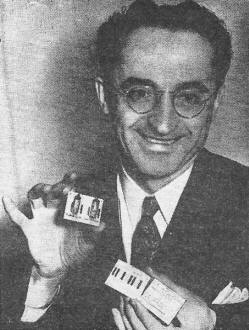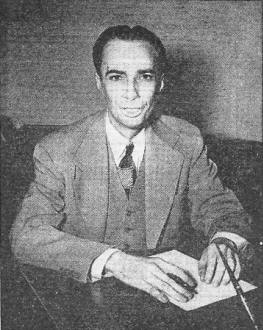|
April 1946 Radio-Craft
 [Table of Contents] [Table of Contents]
Wax nostalgic about and learn from the history of early electronics.
See articles from Radio-Craft,
published 1929 - 1953. All copyrights are hereby acknowledged.
|
Believe it or not, many
countries did - and some still do - charge people wanting to receive
over-the-air (not cable or satellite) commercial radio and/or television
programming a
wireless license fee for the privilege. Yes, this is for receiving, not
transmitting, signals. If you dared to tune in a BBC program without a license,
a fee could be expected upon detection (pun intended). The Monthly Review feature in this 1946 issue of
Radio-Craft magazine reported an increase in cost to the equivalent of $29
in 2021 money (per the
BLS Inflation Calculator). Also highlighted was a method for printing radio
circuits made with conductive inks on ceramic sheets - known today as thick-film
printing. An announcement of the U.S. War Department's 18,000-tube ENIAC
(Electronic Numerical Integrator and Computer) electronic calculating device was
made as well. The electronics field was moving quickly in the post-war
years.
Radio-Electronics Monthly Review

Dr. Brunetti holds one of the little "radio chassis" while demonstrating
how -with the help of sub-miniature tubes - radios can be made smaller than present-day
hearing aids.
Printed Radio Circuits made with conductive inks on ceramic
sheets may make it possible to cut down the size of portable radios far beyond present
concepts of postwar portables, it was revealed last month by Dr. Cledo Brunetti,
of Transitron fame. Tiny radio receivers giving reception equal to that now provided
by table model sets would be possible. The receivers would be no larger than a cigarette
package. Tubes for the circuit have been developed and a special loudspeaker designed.
Miniature battery or house current could supply power. The circuit is printed on
a ceramic , plate, avoiding all the complicated wiring usually found in radio equipment.
It was first used for the proximity fuse, which was a miniature radio set causing
a shell to explode when it approached a target. Dr. Brunetti, who is now with the
Bureau of Standards, explained the printing process to a meeting of radio engineers
at Marquette University: "On a ceramic plate is laid a silk mask with a pattern
cut in it. Over this mask is drawn a plastic bar, like the rollers of a printing
press, with a thick paste of dissolved silver. The impression left on the plate
is like the wiring of the circuit, only instead of copper wires we have silver lines.
"Next another mask is placed over the plate and sprayed with a carbon solution.
When the mask is removed there are all of the resistors assembled in a circuit.
Thin condensers are attached to the circuit and the wiring is completed."
Eighteen Thousand Tubes is the complement of an electronic calculating
device whose existence was announced last month by the War Department. Latest and
mightiest of all electronic calculating machines, it is named ENIAC (Electronic
Numerical Integrator and Computer). The complicated instrument is the invention
of Dr. J. W. Mauchly and Mr. J. Presper Eckert, both of the Moore School, University
of Pennsylvania. The ENIAC is capable of computing 1000 times faster than the most
advanced general-purpose calculating machine previously built. The electronic methods
of computing used in the ENIAC make it possible to solve in hours problems which
would take years on a mechanical machine - a time so long as to make such work impractical.
Although originally developed to compute lengthy and complicated firing and bombing
tables for vital ordnance equipment, it will solve equally complex peacetime problems.
The speed of this computer is phenomenal. The first problem put on the ENIAC, which
would have required 100 man-years of trained computer's work, was completed in two
weeks - of which two hours was actual electronic computing time, and the remaining
time devoted to review of the results and details of operation. If used to complete
capacity, the ENIAC will carry out in five minutes more than ten million additions
or subtractions of ten-figure numbers. The machine lacks one virtue - portability.
It occupies a room 30 by 50 feet and weighs 30 tons.
License Fees on British broadcast receivers were increased last
month from 10 shillings (approximately $2.00) per year, to one pound, or double
that amount. This, British government sources say, will increase revenue from radio
receiving licenses to £10,000,000. Radio listeners and the press are not as well
pleased with the increase as is the government bureau in control of radio (the Post
Office) and the British Broadcasting Co. One headline asks pointedly: "How Will
the BBC Spend that £1? Double Dullness or Better Radio?"

Mr. Charles Denny, Acting Chairman, FCC.
Atom Bomb Tests at Bikini atoll are likely to be televised,
according to a joint Army-Navy statement last month. This would permit "eye-witness"
studies of the explosion which would otherwise be impossible, as experts could not
hope to get near enough to see anything of value and yet survive the explosion.
Under the plan being considered by the joint Army-Navy staff, television transmitters
would be set up on two islands of the Bikini group. The Army-Navy study will be
submitted to Vice Admiral W. H. P. Blandy, test bomb task force commander. Television
receivers would be set up on Blandy's flagship and on the press ship, both of which
would be at least 20, miles from the scene of the test.
Loran, long range radio navigation, is as useful in the air
as aboard ship, stated Lieutenant Commander Lyle C . Read of the United States Coast
Guard last month. Tried out on a test flight, loran showed unmistakable advantages,
according to Commander Read. Its greatest advantage is one that would not be apparent
in surface navigation. In avigation, the time taken to compute positions is very
important, as the speed of the ship is so great that by the time the position is
calculated, the point may have been left many miles behind. Loran, said Read, "is
the only system I know which not only can tell you where you are now, but where
you will be in two minutes, instead of only 'where you were' twenty minutes ago."
A complete description of shipborne types of loran appeared in the January issue
of Radio-Craft.
Posted April 8, 2022
|











